As more people become aware of the harmful effects of welding fumes and regulations are put in place, more are moving to fume extraction torches as a solution.
In this blog we will go into detail on fume extraction torches; how they operate, design features, limitations, and maintenance so that you know what to expect before making the jump.
How Do Fume Extraction Guns Operate?
When you take your first look at a fume extraction torch, you may be intimidated. The added features that we will discuss later, can make the torch look overly complex. In actuality, a fume extraction MIG torch operates, on the welding side, no different from any other MIG welding torch.
They use the same components (consumables, wire, cable, etc.) the only difference is that a fume extraction torch has a housing built-in, around those original components, and a front end opening that we call a “shroud” to extract welding fumes directly at the source. Additionally, there is a larger diameter hose that surrounds the torch cable as a conduit for the smoke to travel to the vacuum unit/system where the smoke is filtered and expelled.
The general functioning principle of a fume extraction MIG torch is to extract the maximum amount of welding fumes possible, without affecting the weld puddle. If the vacuum pressure of the fume extraction torch is too high, you run the risk of extracting your shielding gas, which can lead to porosity in your weld. Start with the same parameters that you normally use and adjust the vacuum pressure around those parameters.
Fume Guns’ Unique Design Features
As stated before, fume extraction torches have all of the same features as your typical MIG torch, with additional features to accommodate fume extraction capabilities. These additional features commonly include:
- Shroud (Front End Opening) – The piece of the fume extraction system that is closest to the weld. It is typically either on top of or near the nozzle of the torch, or sometimes integrated and acting as both the nozzle and shroud. There are many designs options and materials. Common materials used are copper, brass, nickel-plated copper, and even steel if you require a higher durability. As far as designs go, no one option is best; each are made for specific processes.
For example, some manufacturers offer high efficiency shrouds (Figure below) that are larger and slightly closer to the weld. These shrouds would be used more for overhead or out-of-position welding, where capturing fumes is more difficult.
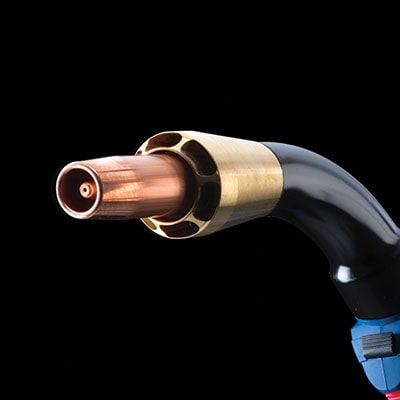
Alternatively, there are tapered shrouds (Figure below) designed to give the welder the most access into a joint as possible. These shrouds are narrower, sit further away from the weld, and have large openings. A tapered shroud wouldn’t work as well for out-of-position welding; just as a high efficiency shroud wouldn’t give you the same joint access that a tapered shroud would.
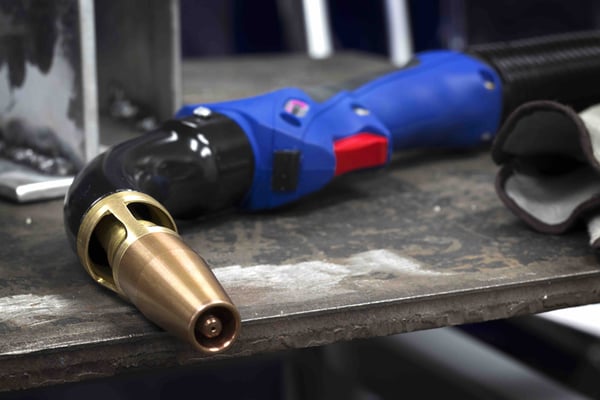
- Neck Design – The neck design of a fume extraction torch is a normal MIG torch neck surrounded by a housing with a large enough gap between the two so that it does not restrict air flow. Neck angles vary slightly between manufacturers, typically anywhere between 45°- 60°. This range allows the torch to be in the optimal position for fume extraction while accommodating the natural posture of the welder.
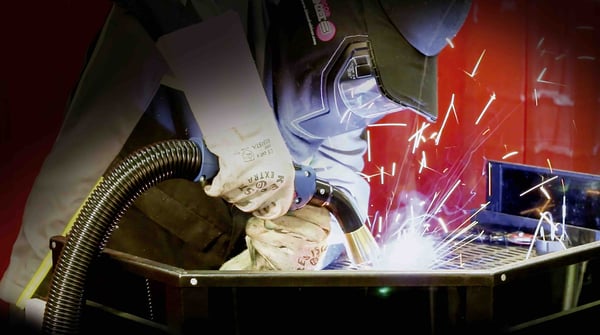
- Handle Design – In order for a fume extraction torch to be efficient, flow throughout the torch needs to be maintained; the torch handle is no exception to that rule. The objective is to keep the handle small enough that it is still comfortable/ergonomic to hold, yet large enough that it allows the proper amount of air flow through the torch.
The handle is the most restrictive piece of a fume extraction torch, so it is important to maximize the space within the handle as much as possible.
- Tapered Consumables – As mentioned before, some manufacturers offer tapered consumables and shrouds for narrow access welds. Using these consumables can allow for proper fume extraction without negatively impacting accessibility or visibility.
It is important to note that when using tapered consumables such as the one on the tapered shroud image above on a fume extraction torch that it will move the shroud slightly further from the weld. This means you will have to increase your vacuum pressure to compensate.
- Miscellaneous – There are a couple design features that are small, but have a significant effect on the torches performance. One of those is the swivel or ball joint that is built into many fume extraction torches. Whether it’s a swivel or a ball joint (swivel joint shown below), the effect is the same; it reduces stress on the welder by allowing the cable and hose to move independently from the torch handle. Although it is minimal, it has been found that some ball joints can affect the flow through the torch by creating a restrictive area, so be aware of that when purchasing your first fume extraction torch.
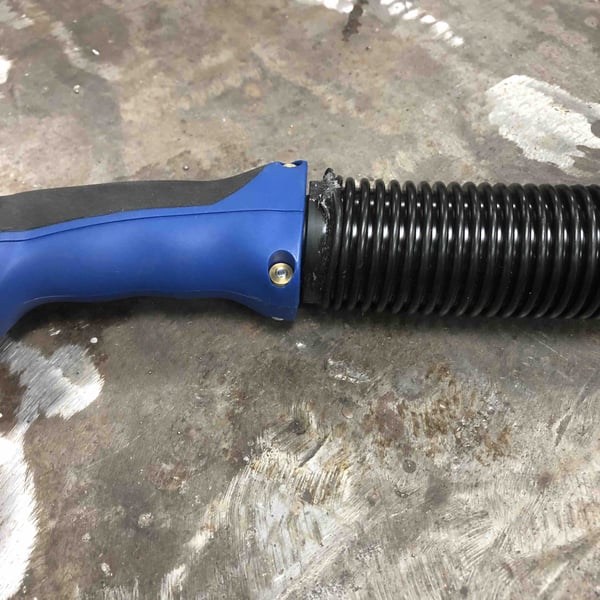
- Hose Connection – Another feature to highlight is the ‘Y’ or ‘T’ hose connection at the back end of the torch. This connection is where the power pin/back end components are located, as well as where the smoke will divert to another hose, that leads to the vacuum system. The 90° ‘T’ connections (Left Image below) that some fume extraction torches have cause the air to slow down significantly when it reaches that point. This causes turbulence in the hose and reduces overall air flow. A larger ‘Y’ connection (Right Image below) solves this issue by providing a gradual curve for the air to travel through, decreasing its resistance and increasing overall air flow.
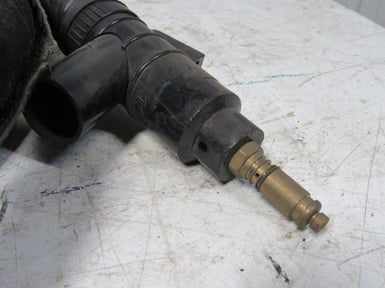

What Do Fume Extraction Guns Remove?
MIG welding can produce fumes that can be extremely harmful with prolonged exposure. These fumes contain microscopic molten metal particles not only from the wire that you are melting, but from the base metal as well.
Some metals are especially harmful, including:
- Stainless Steel
- Manganese
- Galvanized Steel
Short-term exposure to these fumes can result in eye, nose and throat irritation, dizziness, and nausea; while long-term exposure may cause lung damage, as well as various types of cancer (See OSHA document FS-3647). Regardless of the metal you are using, it is of good interest to your health to wear the proper welding equipment and if possible, invest in a fume extraction torch and system.
What are Fume Guns Well-Suited For?
Fume extraction torches are versatile; they are suited for any application that a regular MIG welding torch is used. They are not limited to any one process, application, or position.
The only process that isn’t supported by fume extraction is push-pull welding. Manufacturers have found it to be very difficult to build a fume extraction system over an already over-sized, cumbersome torch.
What are the Limitations of Fume Extraction Guns?
Other than the issue of push-pull torches, fume extraction torches have virtually no limitations.
There is a physical limitation to how effectively a fume extraction system will work, such as when welding with extremely high parameters where the amount of smoke is too much for the system to keep up with; resulting in residual smoke. For these extremely high parameter processes, it may be wise to have a large central vacuum system for each welding station, a portable fume extractor unit, or a clean air hood to solely protect the welder.
Fume Gun Maintenance Needs
Basic maintenance of fume extraction torches is the same as other MIG torches. Replacing the consumables and wire liners is no different, but there are additional features on fume extraction torches that create more maintenance than your average MIG torch.
In order to keep your torch fully functional and efficient at capturing fumes, you must avoid any loss in vacuum pressure. The hose of a fume extraction torch is integral in creating the proper vacuum at the front end of the torch. Any holes, cuts, or openings at any point in the torch or hose can severely impact fume extraction efficiency. Routinely inspecting equipment and repairing when needed will be required to maintain proper fume extraction efficiency.
A part of the preventive maintenance of a fume extraction torch is keeping the interior of the torch handle clean and free of particle build-up. Over time, the particles extracted can get caught in small pockets in the handle of the torch. Once the build-up gets to a certain point it could reduce flow through the torch, producing less efficient fume extraction. The frequency of cleaning the handle depends on the amount of smoke you are extracting, and the type of metals you are welding with. If you notice fume extraction performance decreasing slightly, this should be one of the first items to check.
Keeping the front end free of debris such as spatter is more important than your average MIG torch. If spatter builds up on the front end of the torch, whether it’s directly blocking the shroud or not, it could negatively impact the quality of your weld. In a fume extraction torch, there is a balance between shielding gas and vacuum pressure. If the nozzle of the torch becomes blocked and shielding gas flow is restricted, the minimal shielding gas that gets through could potentially be effected by the vacuum; creating porosity.
It is also very important to keep the vacuum system clean and regularly maintained. This means checking the filter at the beginning of everyday and cleaning or replacing when the filter is dirty. If the filter is left unchecked it could accumulate particles over time and become clogged. This will drastically reduce flow through the torch and you will have little to no fume extraction capability.
Regularly testing your fume extraction system is also recommended to ensure you are achieving the correct flow to produce the desired results. You can read more about how to do so here.
The performance of a fume extraction torch is influenced by many different factors. To be successful, all of these factors must be addressed and in sync with one another. Small things such as leaks, or even improperly set shielding gas can negatively impact the fume extraction performance.
Although this is true, fume extraction torches are the next step in welding to keep welders healthy, as well as keeping work environments clean and safe.
The evidence of the effects of welding fumes is indisputable; they’re dangerous, and applying these systems to your process may be the solution.
Ready for more on fume extraction?
We have an eBook that goes DEEP on fume extraction and getting started, including evaluating different types of fume guns, laws and regulations to look at, which solutions may be right for you, and more!



